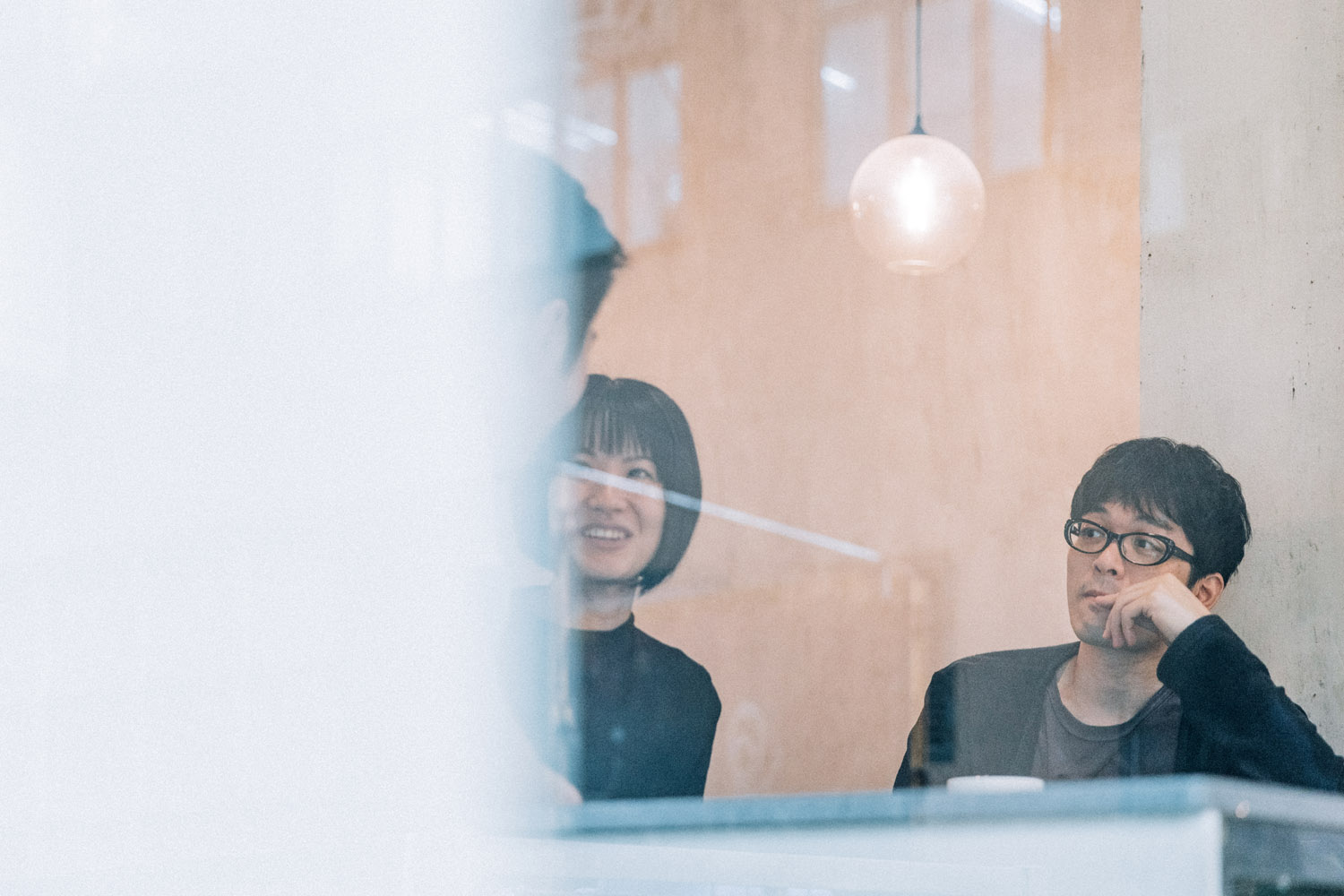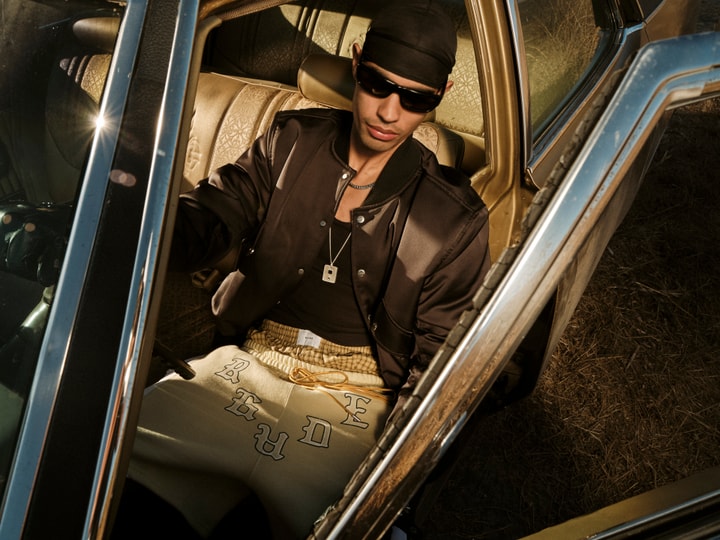Perfect Timing: A Conversation with Kazuki Kuraishi

Before Kazuki Kuraishi was creating graphics next to Sk8thing at BAPE, he would be trailing the mountainous terrains of Colorado, equipped with just his mountain bike and an overflowing sense of curiosity. After spending some time there, he discovered that he was drawn to mountain bike logos and began imagining all the ways graphics could be applied as a means of expression. Emblematic logos covered a bevy of steel tubes in a colorful medley of paint and iconography where ideas for T-shirts would surface. Eventually, he’d travel to New York City to study graphic design, and the rest is history.
These days his garments seem to have shifted gears to a tone that’s predominantly more muted. But behind the subdued exteriors of his recent collections lie complex exoskeletons of considered construction: the result of numerous iterations to simplify. Much like the iPhone, less is more, and the same could be said about the way Kazuki's approach to designing has progressed over the years.
But if we rewind further back past his Colorado days, the person we’d come to discover is the young High School student who had just moved away from home, listened to the Stone Roses religiously and played Soccer in his school team.
We sat down with Kazuki Kuraishi to cover his extensive career as a graphic artist and garment designer. Linking the past to the present, we get a glimpse of some major milestones that have led us to arrive at where he is today.

HBX/HYPEBEAST: What were some of your interests as a teenager?
Kazuki Kuraishi: Soccer and mountain biking.
H: You’ve mentioned before that it was around that time you were mountain biking in Colorado that you discovered an interest in graphic design. Was there a moment of realization for you? What made you decide that you wanted to get into it?
K: When I was in Colorado, naturally, I saw a lot of mountain bikes. Their logos would really strike out to me. I thought the graphics could be put over T-shirts. I think that was probably the realization moment, when I saw all the different logos.
H: Are there any moments that have defined your career that you can share with us?
K: Well it all started from third grade. I had to repeat that year in school because I just wasn’t the best student. My parents ended up sending me to Aomori, a capital city in Northern Japan. Another event that greatly impacted my life was when I lived by myself in High School. I was in a different prefecture from my parents, and most teenagers in Japan live with their family during this time, but I was alone.
H: Were your parents affected by you leaving home at such a young age?
K: Not really [ laughs ]. I am the only child so I feel like they should have been sad, but they didn’t really say anything.
At this point in High School, I was playing soccer for Aomori High, and I was listening to a lot of UK rock bands. I was listening to The Stone Roses quite a bit. Years later, I interned at A Bathing Ape, and through NIGO I was finally able to meet Ian Brown from The Stone Roses. I’d say that the thing that ties my life together is The Stone Roses. They are at the core of my timeline. I was such a big fan, then that lead me to BAPE, so if I didn’t enter BAPE, I would never have met Ian.

H: When did you meet Ian Brown?
K: Probably 1995 or '96.
H: We image getting into A Bathing Ape at the time was no easy task as well. How did that come about?
K: I moved to New York, shortly after my time in Colorado, and at the time, there were many Japanese people coming to New York City. Someone got in touch with me to show NIGO around the city while he was visiting. So I took him to toy stores, shops...etc. We got along quite well, so it was natural that I went over to BAPE. So maybe the connection is more like my connection with the people I have met. I went from liking The Stone Roses in High School, then I was really influenced by Shinsuke Takizawa. That lead to me meeting NIGO, then afterwards Hiroshi Fujiwara, and now back to Ian of The Stone Roses. There were so many great designers at BAPE, so when I was there, I just kept learning, and learning.


H: How many years were you at BAPE?
K: A little less than 10 years or so. 7-8 years? I think it was until 2002.
H: At what point in your career did you shift from pure graphic design to cut-and-sew?
K: When I entered BAPE, I started working for NIGO on graphics. So I was sort of doing the coordination of prints. But it was for the graphics that NIGO wanted. It wasn’t like my idea or purely original — it was what NIGO wanted. And then I started helping this other graphic designer at BAPE. So I became sort of like an assistant for that person. After that, I became like this somewhat known graphic person, instead of an assistant. That’s the first part, with BAPE. After a while, I moved on to making clothes at BAPE as well, but not in a serious way or anything. Not like I did with CASH CA. It was more of a playful thing. Then as I was leaving BAPE, this adidas project came and I did a collab with them. I started helping CASH CA. That’s the time that I started studying about making clothes - whether it was going to school or reading books.
"If I didn’t enter BAPE, I would never have met Ian."
H: You have quite a history of working on multiple projects at the same time. Is that something you picked up from Hiroshi Fujiwara?
K: Hiroshi sort of taught me how to work in that way - he gave me some good advice.
H: We noticed that your bag is kind of like an earthy color right? But if you look at mountain bike graphics, its very bold and artificial, like bright lime, purple, etc… Is that something that changes as you grow older? And then you’re talking about nature. Is there a connection there, moving from bold colorful graphics to more subdued, earthy tones?
K: I think it shifted gradually with age, but that doesn’t mean I wouldn’t ever use bright/loud colors now [laughs]. Maybe it’s not a “maturity” type of thing, but there was definitely an organic development with my tastes where I could appreciate more of those muted colors.
H: How would you summarize your history of work to people that are only just finding out about your work? Before streetwear was widely accepted, and information was hard to find, are there any specific dates that stand out?
K: I think this is the cultural difference between Japan and the West. We actually don’t really focus too much on the year and dates. It’s interesting other countries try to remember the year a specific thing occurred.
H: Why do you think there is this obsession with the past? In the olden days, people were excited about coming up with concepts that they thought would exist in the future. Now, everyone seems to get excited about references to the past.
K: I don’t really keep up with trends, so I am not really sure I can comment too much why 2018 is the way it is, but I do agree that it is a natural phenomenon. It will always repeat in this cycle. Things will come and go, come and go… etc.
I have heard about this fashion trend cycle but never really witnessed it until my current assistant started working with me. He is 21 and he dresses exactly like I did when I was in high school. So I am really living and experiencing this fashion trend cycle. It’s not even a rough approximation of what I used to wear, it IS exactly what I used to wear, down to the details. Fifteen to twenty years ago, I wore chunky sneakers, so now I am very excited that it has made its way back on the market.
H: Do you think this cycle is good or bad?
K: It is not about good or bad. People should consume fashion. This is just a cycle. Fashion won’t be like the automotive industry, where they go through huge breakthroughs and innovations. The innovations in fashion are small.

"Hiroshi sort of taught me how to work in that way - he gave me some good advice."
H: Things such as solar panels in clothing, or even the GORE-TEX fabric membrane are innovative, but these have already been in existence for quite some time.
K: The advancements and innovations are there, they just happen very indiscreetly and are subtle. Take, for example, stretchy fabrics. If something is made with 100% nylon, for someone that makes clothing that’s something super interesting, but on a consumer level, it doesn’t really sound like anything special at all. If it is 90% nylon and 10% elastic yarn, you will still have a stretchy garment, but 100% nylon is something that is more of a recent thing that no one really pays attention to outside of manufacturing.
H: You said earlier that you aren’t really invested in social media, but for today’s generation, the Internet along with social media is how many people get their daily news. Don’t you ever feel like you are missing out on certain things?
K: The time back then was not like it is now. It was very hard to meet someone or even exchange words with someone you respected. Nowadays, you just DM or send an email. It was extremely hard to near impossible back then. Now I am making clothes, and have projects with Ian… This is so much more meaningful to me. So maybe The Stone Roses are the common thread in the story of my life.
H: Do you still have a connection with the time you spent in Colorado? Or is that more of a past chapter of your life?
K: In my time at Colorado, it obviously inspired me to build my foundations. However, that alone wouldn’t be enough to convince me to go back, so I guess we could call it the past. In terms of living outside of Tokyo, I wouldn’t consider Colorado as a place to move to because, for a Japanese, it’s really hard to move to the States. Also, I prefer the snow in Japan better than what you get in Colorado for snowboarding. I might actually consider moving out to Hokkaido where the weather is much cooler during summer.

Kazuki Kuraishi's designs are as deeply layered as his career's expansive timeline: From leaving home as a teenager to riding his mountain bike in Colorado, where he was first inspired; to his humble beginnings at BAPE and meeting frontman of Stone Roses, Ian Brown; or being mentored by Hiroshi Fujiwara and taking up cut-and-sew at CASH CA, Kazuki's progression can be traced through the evolution of his designs. All-too-often we’re encountered with moments, where if Kazuki hadn't been at the right place, or met the right person at the right time, his designs may not have become as intricate as they are today. And it might quite well be to perfect timing where we now arrive to witness once again the changing colors of his work.
